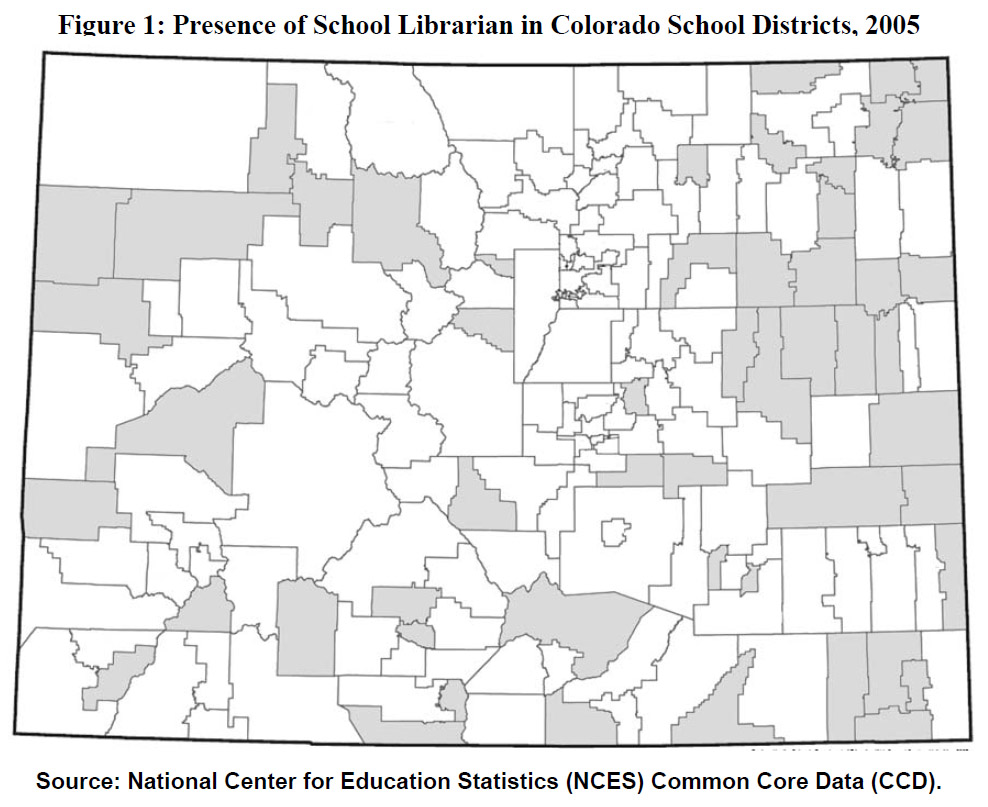Colorado has experienced tremendous population growth over the last several years, and the number of students attending Colorado schools has increased along with the population. On the surface, it appears that the rise in the number of full-time equivalent (FTE) school librarians—as defined by NCES—has kept up with and even surpassed the rise in the student population. However, a closer look reveals that the increase in librarians is primarily benefiting metropolitan-area students.[note]The concept of a metropolitan area for this report is derived from the U.S. Census Bureau: “The general concept of a metropolitan or micropolitan statistical area is that of a core area containing a substantial population nucleus, together with adjacent communities having a high degree of economic and social integration with that core. … Each metropolitan statistical area must have at least one urbanized area of 50,000 or more inhabitants.” Source: http://www.census.gov/population/www/estimates/aboutmetro.html. For our purposes, metropolitan area school districts were those that are in Adams, Arapahoe, Boulder, Denver, Douglas, El Paso, Jefferson, Larimer, Mesa, Pueblo, and Weld Counties.[/note]
Figures reported by school districts and collected by the National Center for Education Statistics (NCES)[note]Source: NCES Common Core Data. The Common Core of Data (CCD) survey annually collects data about all public schools, public school districts, and state education agencies in the United States. See: http://nces.ed.gov/ccd/.[/note] indicate that the state’s schools saw an overall increase of 10 percent in the number of students from 1999 to 2005. The number of FTE school librarians in schools grew 15 percent in that same time period (see Table 1).
Each year the National Center for Education Statistics (NCES) collects data for the Common Core of Data (CCD). This collection is conducted by state education agencies and includes data reported by all public schools and districts in the U.S. The data presented here is from the CCD and is used to describe the number of librarians in Colorado’s schools and districts.
Accordingly, the definition of a librarian used throughout this Fast Facts is the NCES definition: “A professional staff member or supervisor assigned specific duties and school time for professional library services activities. These include selecting, acquiring, preparing, cataloging, and circulating books and other printed materials; planning the use of the library by students, teachers, and instructional staff; and guiding individuals in the use of library books and material maintained separately or as a part of an instructional materials center.”[note]The National Center for Education Statistics defines a school librarian as “A professional staff member or supervisor assigned specific duties and school time for professional library services activities. These include selecting, acquiring, preparing, cataloging, and circulating books and other printed materials; planning the use of the library by students, teachers, and instructional staff; and guiding individuals in the use of library books and material maintained separately or as a part of an instructional materials center.” Source: http://nces.ed.gov/ccd/pdf/psu051agen.pdf.[/note]
Note, this definition does not differentiate between positions requiring a Colorado Department of Education school librarian endorsement and those not requiring such credentials.
As would be expected, there is a disparity in population increases between metropolitan and non-metropolitan areas of Colorado. In metropolitan areas, student population has increased nearly 12 percent. In non-metropolitan areas, the number of students has increased only 1 percent (see Table 2).
Districts Without Librarians
Despite this rise in number of students and librarians over this 6 year period, there was an increase in the number of school districts without any school librarians, rising from 39 such districts in 1999 to 51 in 2005. However, as a group metropolitan districts were not affected by this trend. In fact, the number of districts in metropolitan areas without a school librarian dropped from 8 to 5. Whereas, the number of districts outside of metropolitan areas without a librarian increased by almost 50 percent, from 31 to 46 (see Table 3).
This can be seen graphically on a map of school districts in Figure 1. The shaded districts are those without school librarians as reported by the school districts in 2005 (see NCES Data and Definitions, page 1).
This trend is mirrored when we look at the number of FTE librarians per 1,000 students in metropolitan versus non-metropolitan areas. The ratio of librarians per student in metropolitan school districts grew 9 percent between 1999 and 2005. In non-metropolitan areas that number actually fell 11 percent (see Table 4).
These figures indicate a troubling trend for school libraries in non-metropolitan areas. It appears that gains made in the number of school librarians are only in school districts near large urban areas. As various studies[note]See “How School Librarians Help Kids Achieve Standards : The Second Colorado Study (2000)” by Keith Curry Lance et al., http://www.lrs.org/impact.php.[/note] have shown that students at schools with well-developed school library programs fare better on standardized tests, it is important to not take the loss of these library positions for granted.





